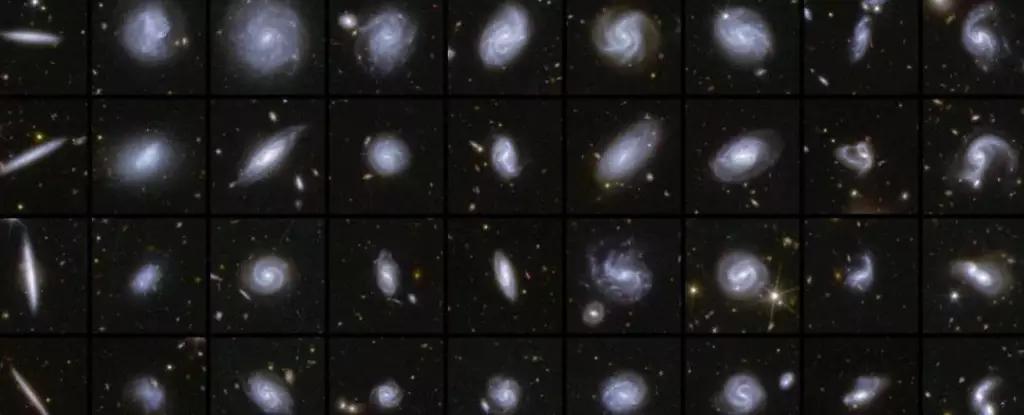The European Space Agency’s Euclid Space Telescope has emerged as a revolutionary project for modern astrophysics, debuting in July 2023 with a promise that extends far beyond beautiful images of the cosmos. With its sophisticated technology, Euclid is engaging in a quest not just to capture stunning celestial visuals like the Horsehead Nebula but to fundamentally enhance our understanding of the very fabric of the Universe. Its primary mission? To navigate the mysteries of cosmic expansion and the hidden forces that govern it.
Utilizing a state-of-the-art 600 MB camera, Euclid gathers intricate details of galaxies and cosmic structures up to an astonishing 10 billion light-years away. The telescope’s capability to image vast swathes of the night sky—instead of just focusing on sporadic objects—allows it to stitch together a comprehensive map of the Universe’s large-scale structure. This ambitious task positions Euclid not only as a technological marvel but also serves as a monumental leap in our understanding of dark matter and dark energy, two of the most enigmatic components of our Universe.
Deep Fields: A Window into Cosmic Evolution
Recently, Euclid unveiled its inaugural images of the “Deep Fields”—specific regions of the sky designated for prolonged observation. These Deep Fields are critically important, as previous observatories like Hubble have demonstrated their capacity to reveal invaluable insights into the nature of our Universe. The initial scans have already unveiled a treasure trove of data, identifying gravitational lenses, previously unknown galaxy clusters, and a myriad of unique galaxy formations.
The significance of deep field observations cannot be overstated. Each image acts as a time capsule, providing hints about cosmic evolution, the distribution of dark matter, and the processes that shape galaxy formation. The first dataset released from Euclid records a staggering 26 million galaxies, far surpassing our previous capabilities. The telescope’s ongoing mission, projected to continue until 2030, suggests that this is merely the tip of the iceberg in terms of astronomical discovery.
Tools of Discovery: Understanding Dark Matter and Dark Energy
Central to Euclid’s mission are its two advanced instruments: the Visible Imaging Channel (VIS) camera and the Near-Infrared Spectrometer and Photometer (NISP). The VIS captures high-resolution images, while NISP is tasked with measuring the distances and masses of galaxies—data crucial for deciphering the cosmic web, a structural matrix of dark and visible matter where galaxies are found.
Dark matter and dark energy continue to baffle scientists, comprising a significant portion of the Universe yet remaining largely undetectable by conventional means. This is where Euclid steps in, delivering a ground-breaking observational capability that bridges our gaps in understanding. As Clotilde Laigle, a Euclid Consortium scientist, suggests, it is not until the completion of the mission that we will truly unlock the full potential of Euclid in terms of understanding these cosmic phenomena. However, even the volume of initial data serves as a unique lens through which we can study the organizational dynamics of galaxies.
The Power of Collaboration: AI, Citizen Science, and Expert Analysis
Perhaps one of the most fascinating aspects of the Euclid mission is its ability to blend cutting-edge technology with human expertise. The recent release of a catalogue including 500 strong gravitational lenses illustrates this approach beautifully. Many of these lenses were previously unknown, underscoring the collaborative efforts at play—where artificial intelligence assists in data sifting, citizens contribute to the analysis, and experts validate findings. This integrated methodology enhances the scale of discoveries and strengthens our interpretation of the data.
As Pierre Ferruit, ESA’s Euclid mission manager, points out, this project represents an unprecedented synergy among various data-processing methods. The implications are profound: as we accumulate immense datasets, being able to efficiently analyze the information will be vital for understanding the complexities of the Universe. The power of collaboration—between technology and human insight—will inevitably unlock new dimensions in astrophysical research.
Anticipating the Future: The Legacy of Euclid
The parallels between Euclid and earlier missions such as Gaia are enlightening. Gaia, tasked with constructing an extraordinarily precise map of our Milky Way, has already reshaped our understanding of galactic structures. Euclid is poised to similarly impact our comprehension of the Universe’s large-scale architecture.
As we venture further into this daring new era of cosmic exploration, the early data from Euclid brings excitement and anticipation. The conversations surrounding dark matter and dark energy are invigorated by the potential insights the telescope promises. In a broader context, what Euclid accomplishes in the coming years may redefine our fundamental theories about the cosmos and our place within it. Astronomers around the world are brimming with enthusiasm, awaiting not just images but knowledge that could shift the paradigms of astrophysics as we know it. The unlocking of this data treasure trove is poised to generate ripples across scientific fields, heralding a future where the mysteries of the Universe may finally come to light.


Leave a Reply